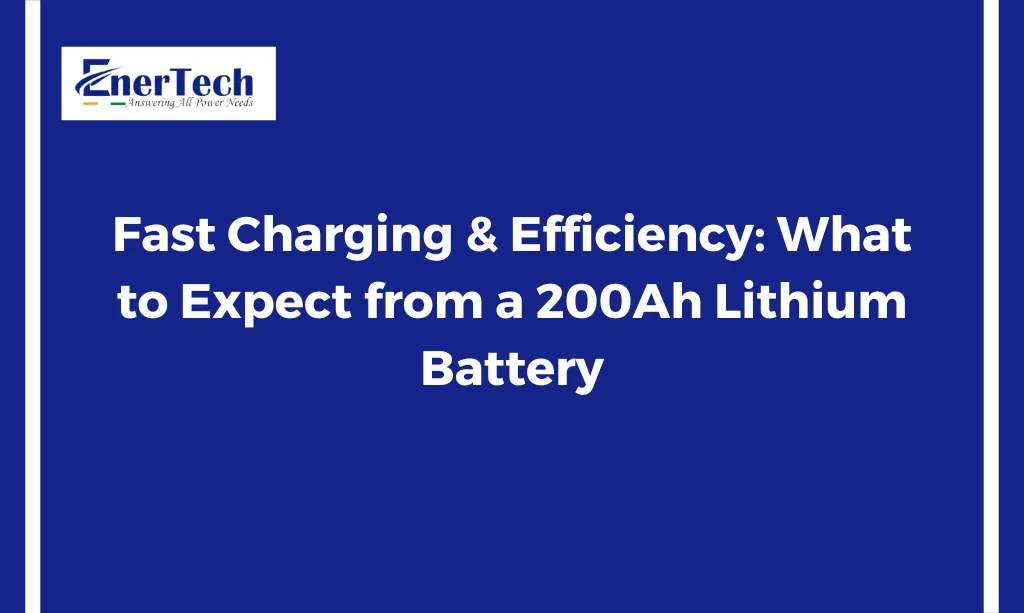When it comes to modern energy storage, the 200Ah lithium battery stands out for its unmatched charging efficiency, rapid power delivery, and long operational life. Whether used for solar energy systems, inverters, RVs, or marine applications, this battery technology outperforms traditional lead-acid systems in almost every aspect. Let’s explore how it achieves fast charging, minimizes energy loss, and maintains consistent performance even under varying environmental conditions.
Understanding the 200Ah Lithium Battery
A 200Ah lithium battery—often based on LiFePO₄ (Lithium Iron Phosphate) chemistry—stores enough power to run large home inverters or off-grid systems for hours. Compared to lead-acid batteries, it offers higher energy density, lightweight design, and exceptional depth of discharge (up to 90–95%). This means more usable energy and greater efficiency per cycle.
Lithium batteries are designed to deliver power consistently while maintaining voltage stability throughout the discharge cycle, making them ideal for both residential and commercial setups.
Fast Charging Capabilities
One of the most notable advantages of a 200Ah lithium battery is its fast-charging feature. Unlike lead-acid batteries that require 8–10 hours to reach full charge, lithium batteries can often be fully charged within 2–4 hours, depending on the charger’s specifications and current input.
This rapid charging ability comes from lithium’s low internal resistance and high charge acceptance rate. Modern Battery Management Systems (BMS) ensure safe and efficient charging by regulating voltage and current while protecting against overcharging or overheating.
In solar applications, this feature is particularly beneficial—when sunlight hours are limited, a fast-charging 200Ah lithium battery ensures you capture and store maximum energy for later use.
Superior Efficiency Compared to Lead-Acid
Efficiency is where lithium batteries truly shine. A 200Ah lithium battery boasts 90–95% charge/discharge efficiency, whereas traditional lead-acid batteries offer only around 70–80%. This means less energy wasted during each cycle, resulting in significant long-term savings on energy consumption.
Lead-acid batteries also suffer from voltage drops during discharge, which affects performance and runtime. In contrast, lithium batteries maintain a consistent output voltage, ensuring reliable performance for devices and appliances that require stable power.
Additionally, lithium batteries do not require equalization charging or maintenance, making them more convenient and cost-effective over their lifespan.
Reduced Power Losses
Power loss is a hidden factor that impacts battery performance. With lead-acid batteries, internal resistance and chemical inefficiency cause noticeable heat generation and energy waste. A 200Ah lithium battery, however, minimizes these losses thanks to its advanced internal design and stable chemical composition.
The lower internal resistance results in reduced heat buildup and enhanced energy conversion efficiency. This efficiency also allows more accurate state-of-charge (SOC) readings and improved performance under heavy load conditions.
Effect of Ambient Temperature
Temperature plays a crucial role in determining battery performance. Lead-acid batteries tend to lose capacity and efficiency in cold environments and degrade faster in heat. Lithium batteries, on the other hand, perform reliably in a wider temperature range—typically between -10°C to 55°C.
That said, extreme temperatures can still affect lithium batteries. High heat can accelerate aging, while very low temperatures can reduce charging efficiency. Fortunately, most modern 200Ah lithium batteries come equipped with built-in temperature protection or smart BMS systems to maintain safe operating conditions automatically.
In moderate climates, users can expect optimal performance with minimal degradation over thousands of cycles—often exceeding 3,000–5,000 charge cycles, compared to 500–800 for lead-acid.
Long-Term Performance and Cost Efficiency
Though the initial investment in a 200Ah lithium battery may be higher, the long-term benefits far outweigh the cost. With longer lifespan, higher energy efficiency, and lower maintenance requirements, users typically save more over time.
Fast charging reduces downtime, while higher efficiency ensures every watt of energy is utilized effectively. For solar and inverter users, this means better energy independence, less reliance on grid power, and a more sustainable energy solution.
Learn more: Ultimate Guide to Lithium Ion Battery for Inverter: Types, Benefits
Conclusion
A 200Ah lithium battery represents the future of energy storage—offering fast charging, high efficiency, and reliable performance across varying conditions. Its superior technology minimizes power loss, maximizes usable energy, and supports a longer operational life, making it the preferred choice over traditional lead-acid batteries.
Whether you’re upgrading a solar system, powering an off-grid setup, or improving backup efficiency, investing in a 200Ah lithium battery ensures smarter, faster, and cleaner energy for years to come.
Enertech has an answer for your search for premium-quality lithium ion battery for inverters. We’ve been serving in the solar business for years and have built an unmatched reputation through results that also forms the reason for our success. We focus on sustainable value and this approach of ours reflects in our products, to which inverters aren’t an exception. We provide exceptional consulting and remarkable after-sales support that enables our clients to make the right choice and nurture it for a long time. Click here to explore our lithium ion battery for inverter product range, or please email us at sales@enertechups.com to know the solar power inverter cost.




